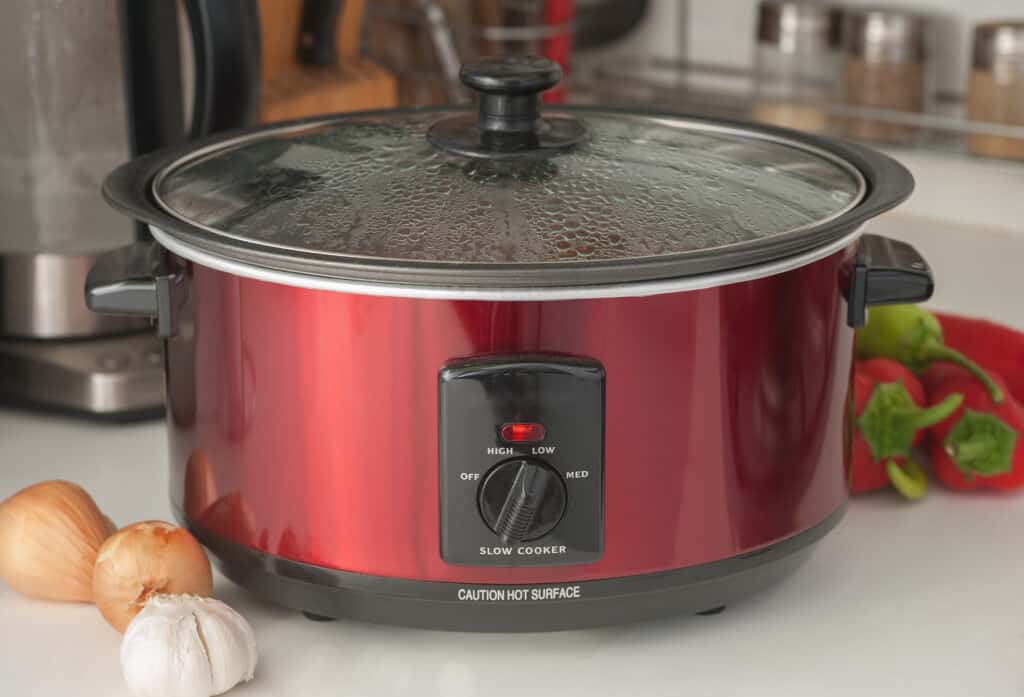As an avid cook, I have always been a fan of using slow cookers for their convenience and ability to create flavorful meals with minimal effort.
However, something that has puzzled me for a while is why slow cooker lids sometimes shatter. This can be startling and dangerous, and understanding the reasons behind it will ensure a safer and more enjoyable cooking experience.
In my research, I discovered that there are several factors contributing to slow cooker lids shattering. One such factor is extreme heat and temperature shocks due to the lid’s construction.
Most slow cookers come with glass lids that can retain heat up to a certain level, but when exposed to sudden temperature fluctuations, they can develop microfractures. These microfractures weaken the glass and can cause it to shatter during use or even later on.
Another factor I found is the lid quality itself, as most slow cooker lids are made with regular glass, which is more prone to breaking with even minor mishandling compared to more robust materials like tempered glass.
Additionally, improper washing methods and continually exposing the lid to temperature changes can further weaken the glass and increase the likelihood of shattering.

Slow Cooker Lids – Causes of Shattering
In this section, I will discuss the various causes that can lead to slow cooker lids shattering. These causes can be categorized into three main categories: temperature changes, material flaws, and misuse.
Temperature Changes
One of the primary reasons for slow cooker lid shattering is sudden temperature fluctuations. This can occur when a hot glass lid comes into contact with a cold surface, or when cold water is poured on a heated lid. These rapid changes in temperature can cause microfractures in the glass, which weaken the lid and may eventually lead to shattering.
Material Flaws
Another cause of slow cooker lid breakage is the quality of the material used. Most lids are made from regular glass, which is more susceptible to breaking, even with minor mishandling. High-end materials, like Pyrex, might provide better resistance to shattering. It is essential to pay attention to the quality of the material when choosing a slow cooker to ensure better durability of the lid.
Misuse
Improper handling and cleaning practices can also contribute to slow cooker lid shattering. Using abrasive scouring pads to clean the glass lid may cause scratches, either visible or invisible to the eye, that can weaken the glass and lead to its eventual breakage. It is vital to handle and clean the lid gently and appropriately to avoid such issues.
Besides these three main factors, additional elements such as manufacturing defects or mechanical stress on the glass lid might also contribute to shattering.
However, by understanding the common causes and taking the necessary precautions, one can reduce the likelihood of slow cooker lid shattering and prolong the lifespan of the appliance.
Prevention Tips
Slow Cooker – Proper Use
While using a slow cooker, it’s essential to follow the manufacturer’s instructions to prevent the lid from shattering. Here are a few tips to ensure safe cooking:
- Do not latch the slow cooker lid while cooking, as it can trap excess steam and cause pressure to build, potentially leading to the lid shattering.
- Only use the lid specifically designed for your slow cooker model, as using a substitute can result in a poor seal and increased risk of breaking.
- Avoid sudden temperature changes, such as placing a cold lid on a hot slow cooker, as this can weaken the glass and cause it to shatter.
Storage
Proper storage is crucial in preventing slow cooker lid breakage. Keep these points in mind:
- Store the lid separately from the slow cooker base, ideally in a cushioned area to prevent any accidental damage.
- Keep the lid and slow cooker in a dry, cool place, away from direct sunlight or sources of heat, to avoid weakening the glass due to temperature fluctuations.
Cleaning
When it comes to cleaning the slow cooker lid, following a few simple steps can help prevent shattering:
- Allow the lid to cool down to room temperature before washing, as exposing a hot lid to cold water can cause it to shatter.
- Use gentle, non-abrasive cleaning materials, such as soft sponges or cloth, to avoid scratching or damaging the surface of the lid.
- Be cautious not to apply excessive pressure while washing or drying the lid, as this can cause it to crack.
Common Myths and Facts
In my experience with slow cookers, I have come across several myths and misconceptions surrounding why slow cooker lids shatter. Let’s discuss some common myths and the actual facts related to slow cooker lid shattering.
Myth 1: Lifting the lid ruins dinner. While it is true that lifting the lid frequently during cooking can cause the temperature inside the pot to drop and extend the overall cooking time, this is not the reason slow cooker lids shatter. In fact, occasional lifting of the lid to check or stir the contents is not harmful and will not lead to lid shattering.
Myth 2: Overfilling the slow cooker leads to lid shattering. Overfilling a slow cooker can cause the contents to bubble over or create a hard mass stuck to the bottom. However, this is not directly related to the shattering of slow cooker lids. It’s important to follow the manufacturer’s guidelines for filling to avoid such issues, but be aware that they are separate from the concern of lid shattering.
Myth 3: Cleaning a slow cooker with baking soda or vinegar prevents lid shattering. Although baking soda and vinegar are effective in cleaning burnt or stuck-on foods from slow cookers, they don’t play a role in preventing lid shattering. Proper cleaning does help maintain the efficiency and longevity of the slow cooker, but it won’t protect the lid from potential shattering issues.
Now, let’s talk about the facts. In reality, the primary reason slow cooker lids shatter is due to pressure build-up inside the pot. When the lid is clamped down tightly, it can transform the slow cooker into a makeshift pressure cooker, which the slow cooker is not designed to handle. This pressure build-up can ultimately cause the lid to shatter.
To prevent slow cooker lid shattering, it’s crucial to ensure the lid is not clamped down too tightly and that the slow cooker is not being used in a manner that could cause pressure to build up. By using the slow cooker as intended and avoiding common misconceptions, you can enjoy delicious, slow-cooked meals without the fear of a shattered lid.

What to Do in Case of Shattering
When a slow cooker lid shatters, the first thing that goes through my mind is the safety of everyone nearby. Shattered glass can be dangerous and it’s crucial to handle the situation properly. In this section, I’ll provide some guidance on how to handle a shattered slow cooker lid, including cleanup and replacement.
Cleanup
Before I begin the cleanup process, I make sure to turn off the slow cooker and unplug it from the wall. Then, I allow the appliance to cool down for a few minutes to avoid any further damage or injury. Once the slow cooker has cooled, I’ll gather the necessary supplies:
- Thick gloves to protect my hands
- A broom or vacuum cleaner to collect shards of glass
- A damp cloth for wiping the surrounding area
- A sealable container or plastic bag for glass disposal
With these supplies in hand, I then put on the gloves to protect myself from the shards. Carefully, I start to pick up the larger pieces of glass and place them into the container or bag. After collecting the larger pieces, I use the broom or vacuum cleaner to sweep up any smaller shards. Finally, I use the damp cloth to wipe the surrounding area to ensure there are no remaining pieces of glass.
Replacement
Replacing the shattered lid of my slow cooker is a crucial step to ensure the appliance can be used safely in the future. I first check if the manufacturer offers replacement lids for my specific slow cooker model. In most cases, companies like Hamilton Beach provide lids that can be easily ordered online through their website or other retail platforms. If a replacement lid is not available from the manufacturer, I may consider looking for a compatible, generic lid from other sources. However, I always make sure that the lid is designed for use with slow cookers and fits my appliance properly to ensure safe and efficient cooking.
FAQ: Slow Cooker Lid Shattering
Many users of slow cookers have concerns about the shattering of cooker lids. In order to clear up any confusion and provide accurate information, I have compiled a list of frequently asked questions on this topic.
1. Why do slow cooker lids shatter?
Slow cooker lids, which are typically made of glass, can shatter due to extreme temperature changes or excessive heat. If a cooker is left on for too long, the heat may build up and cause the lid to break.
2. How can I prevent my slow cooker lid from shattering?
To minimize the risk of lid shattering, it is important to avoid clamping down the lid tightly. Clamping the lid can turn the slow cooker into a pressure cooker, creating heavy pressure that the lid is not designed to handle. Additionally, make sure not to use excessive heat settings or leave the cooker on for longer than recommended.
3. What should I do if my slow cooker lid has already shattered?
If your slow cooker lid has shattered, it is recommended to replace the lid rather than attempting to fix it. A damaged lid may have microfractures that can weaken the glass, increasing the risk of future breakage. Check with the manufacturer for replacement parts or consider purchasing a new slow cooker.
4. Are there any materials that are less likely to shatter?
While glass is the most common material for slow cooker lids, some manufacturers offer lids made of metal or other materials. These alternatives may be less prone to shattering but may not provide the same level of visibility during cooking. It is important to consider the pros and cons of each material before making a decision.
5. How can I safely clean my slow cooker lid to minimize the risk of shattering?
When cleaning your slow cooker lid, it is best to avoid exposing it to extreme temperature changes or using abrasive cleaning tools. Instead, gently wash the lid with warm, soapy water and a soft cloth, and let it air dry.
Conclusion
In conclusion, several factors contribute to the shattering of slow cooker lids. These factors include excessive heat and pressure build-up, improper usage, and the type of material used in the lid’s construction. To prevent such incidents, I recommend the following precautions:
- Ensure the lid does not clamp down too tightly, as this can cause the slow cooker to transform into a pressure cooker.
- Use a lid with a hole at the top to allow excess heat and steam to escape, reducing the chances of shattering.
- Monitor the cooking temperature and time to prevent overheating.
- When removing the lid, be careful to avoid rapid temperature changes that may cause the glass to shatter.
- Opt for slow cooker lids made from materials designed to withstand high temperatures and pressure, such as tempered glass or heat-resistant plastics.
By taking these precautions and paying attention to the proper use and maintenance of the slow cooker, I can minimize the risk of a shattered lid and enjoy the many benefits of slow cooking.





